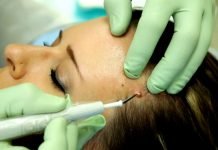Chemical Peel Treatment And Its Types
Chemical Peel Treatment And Its Types
Chemical peel treatment is among the most popular non-invasive cosmetic procedures in all over the world.
This is due to their immediate results, affordable prices, and the fact that they have performed as a simple outpatient procedure, painless and quick.
Chemical peel treatment in Delhi:
All chemical peel treatment perform the same function: they work by removing the outermost layers of skin through what is referred to as a controlled injury.
The chosen chemical breaks down the bonds between dead skin cells and allowing them to peel and flake away.
This procedure reduces wrinkles, evens out minor scars and blotchy patches, and can even help to treat sun damage and also work for Skin whitening in Delhi
Undergoing chemical peels on a regular basis every 6 to 8 weeks can also help to increase the production of collagen, one of the proteins responsible for maintaining the skin’s elasticity and structure.
Chemical peels offer optimal results when performed by a Dermatologist in Delhi or in a qualified professional’s clinic.
While there are at-home chemical peel products you can apply yourself also, these cannot reach the level of depth that a specialist can administer
While chemical peels provide excellent results for many common skin conditions like pigmentation removal in Delhi, wrinkle removal, dark spot removal etc, there are also certain things they cannot achieve.
For example, chemical peels are ineffective in reducing the appearance of blood vessels, keloid scars, or sagging skin.
Furthermore, chemical peels are not usually recommended for discolouration in patients with darker skin tones.
The 3 main types of chemical peels:
There are three different types of chemical peels and a variety of different peeling agents. Each type of peel penetrates the skin to different depths.
The degree of depth achieved by peels depends on the strength of the acid used as the peeling agent, the number of coats that are applied, and the amount of time the acid is given to work before being neutralized.
The deeper the peel, the more dramatic the results. That being said, deeper peels also carry a higher risk, side effects, are more painful and take longer to heal.

Light peels:
These are the gentlest variation of peel available. In fact, superficial peels are so gentle they are considered one of the few true lunchtime peels they only remove the very uppermost layer of the skin, called as the epidermis
Light peels minimize the appearance of fine lines and fine wrinkles, mild acne scarring, age spots, and dry, flaky or sun damaged skin. This results in skin that looks instantly brighter, smoother, and more even in texture.
They usually contain mild alpha hydroxy acids or beta hydroxy acids, and other simple organic acids found in fruits.
They can be used on all skin types and tone and are ideal for people who want the benefits of a facial peel but don’t want all the downtime and pain associated with deeper peels.
Medium peels:
Medium depth peels offer a more dramatic end result than shallower, more superficial peels. Generally using trichloroacetic acid as an active agent for peeling.
These chemical peels soak deeper into the skin. This allows them to treat issues such as sun damage, discolouration, and wrinkles.
The downside, however, is that medium depth peels require longer recovery time and have in some cases been linked to unpleasant side effects and risks
The face can become swollen, itchy, and reddened, with some patients reporting burning or stinging sensations that last up to an hour after the treatment.
Medium depth peels can also cause patches of brown and white skin to appear on the face during the recovery process. And in rare cases, medium depth peels have resulted in scarring.
Generally, recovery from medium-strength peels take about a week, but you might still be a little pink for as long as six weeks after treatment.

Deep peels:
These are, by far, the strongest type of chemical peels available in the market penetrating far into the dermal layers of skin.
Deep peels usually use carbolic acid, also known as phenol, or a concentrated, high strength TCA as their active agent.
While deep peels can provide amazing results for sun damaged skin, dark spots, scarring, and deep lines and wrinkles, the procedure can be quite painful.
After a deep peel, your face will look and feel as though it has been severely sunburned. While you should be fully healed within a matter of weeks, the redness can last for months also.
The side effects can be quite dramatic that include your face will remain swollen for days, after which itchy, peeling scabs will start to form.
For some patients, a full two weeks of recovery are required before they feel comfortable going out in public.
The most common risks associated with deep peels are the development of permanent patches of white or bleached looking skin, and an increased risk of scarring also.
Darker-skinned people, people who are sensitive to anaesthesia, as well as those with heart problems, make poor candidates.
It is also important to note that anyone who decides on a deep peel treatment should be prepared for a more lengthy recovery.
Adorable Clinic is best for chemical peel treatment in Delhi. If you want to remove your skin imperfections and want a peel away your skin conditions then contact us on 097111 50928.







 WhatsApp us
WhatsApp us